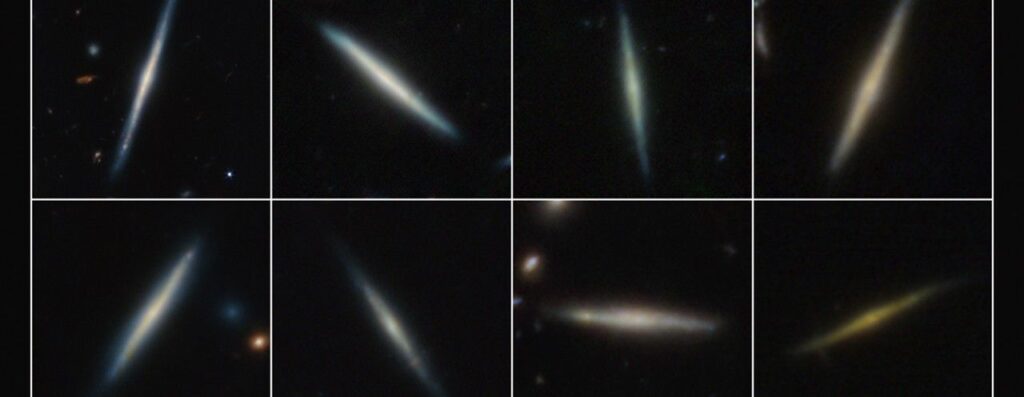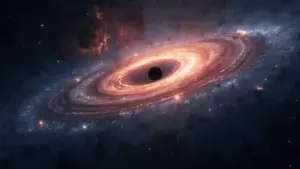
Present-day disk galaxies often feature a thick, star-filled outer disk and a thinner, embedded disk. The Milky Way, for example, has a thick disk approximately 3,000 light-years in height and a thin disk about 1,000 light-years thick. The mystery of how and why this dual disk structure forms has long intrigued astronomers. Now, thanks to NASA’s James Webb Space Telescope, a team of researchers is closer to solving this cosmic puzzle.
By analyzing archival data from multiple observational programs, the team has identified and visually verified a statistical sample of 111 edge-on disk galaxies, spanning up to 11 billion years ago, or roughly 2.8 billion years after the Big Bang. This marks the first time scientists have investigated thick- and thin-disk structures across such vast distances, bridging the gap between early universe observations and the study of our own galaxy’s history.
Groundbreaking Observations with Webb
“This unique measurement of the thickness of the disks at high redshift is a benchmark for theoretical study that was only possible with Webb,” said Takafumi Tsukui, lead author of the study and a researcher at the Australian National University in Canberra. “Usually, the older, thick disk stars are faint, and the young, thin disk stars outshine the entire galaxy. But with Webb’s resolution and unique ability to see through dust and highlight faint old stars, we can identify the two-disk structure of galaxies and measure their thickness separately.”
The analysis suggests that thick disk formation occurs first, followed by thin disk formation, with the timing dependent on the galaxy’s mass. High-mass, single-disk galaxies transitioned to two-disk structures around 8 billion years ago, while low-mass galaxies formed their thin disks about 4 billion years ago.
Unveiling the Turbulent Origins of Disk Galaxies
To understand the transition from a single, thick disk to a dual-disk structure, the researchers examined additional data from the Atacama Large Millimeter/submillimeter Array (ALMA) and ground-based surveys. These observations support the “turbulent gas disk” scenario, one of three major hypotheses explaining disk formation. In this model, a turbulent gas disk in the early universe triggers intense star formation, creating a thick stellar disk. As stars form, they stabilize the gas disk, reducing its turbulence and leading to the formation of a thin disk.
“This is the first time it has been possible to resolve thin stellar disks at higher redshift. What’s really novel is uncovering when thin stellar disks start to emerge,” said Emily Wisnioski, a co-author of the paper at the Australian National University in Canberra.
The findings indicate that massive galaxies, capable of more efficiently converting gas into stars, settle sooner than their low-mass counterparts, resulting in earlier thin disk formation. Importantly, thick- and thin-disk formation are not isolated events; the thick disk continues to grow, albeit at a slower rate than the thin disk.
Implications for Our Galactic Neighborhood
Webb’s sensitivity allows astronomers to observe smaller and fainter galaxies, akin to the Milky Way, at early times and with unprecedented clarity. The study’s findings suggest that the transition from thick to dual-disk structures coincides with the formation of the Milky Way’s thin disk. This insight could help astronomers explore Milky Way-like progenitors and shed light on our galaxy’s formation history.
Looking ahead, the team plans to incorporate additional data points into their edge-on galaxy sample. “While this study structurally distinguishes thin and thick disks, there is still much more we would like to explore,” Tsukui remarked. “We want to add information typically obtained for nearby galaxies, like stellar motion, age, and metallicity. By doing so, we can bridge insights from galaxies near and far and refine our understanding of disk formation.”
The Future of Galactic Exploration
The results of this study were published in the Monthly Notices of the Royal Astronomical Society. The James Webb Space Telescope continues to be the world’s premier space science observatory, unraveling the mysteries of our solar system, distant worlds, and the universe’s origins. With its international collaboration between NASA, ESA, and CSA, Webb is poised to make even more groundbreaking discoveries.
For further information about the James Webb Space Telescope, visit NASA’s official site.





